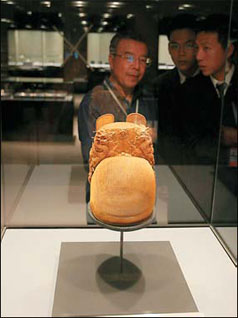
A Yuan Dynasty (1271-1368) Jingdezhen blue-and-white porcelain of a Bodhisattva.
It is scarcely believable but it is true. Some of the most precious relics this ancient country has - Xi'an's terracotta warriors such as - have been gathered under one roof and can be seen by visitors to Beijing for the next three months.
Two years in the making, the Grand Cultural Relics Exhibition at the Capital Museum is actually five exhibitions in one.
Liu Chaoying, director of the museum department of Beijing's Administration of Cultural Heritage, summed up what many people are sure to feel. "There has surely never been anything to compare with this," she says.
There is no exaggeration in her comment - hundreds of exhibits, the most precious items from more than 70 museums in 27 provinces around China, have been amassed to celebrate the Beijing Olympics.
Consider just a few: a pottery bowl decorated with fish and human masks dating back to the Yangshao Civilization (BC 5000-3000) of the Neolithic Age; bronze masks with protruding eyes from Sanxingdui and from the Shang Dynasty (BC 1300-1046); the incomparable terracotta warriors and horses of the Qin Dynasty (BC 221-206); a jade burial suit from the Western Han Dynasty (BC 206-AD 25) and a ceramic figurine of a story teller from the Eastern Han Dynasty (25-220). Many of these will be familiar to people from all around the world and now you can see them all at once.
"There were two criteria that exhibits had to meet," says Liu.
"One was those which were so important as to be pictured in history books at school. "The others are newly-unearthed relics which have not been shown to the public."
Some of the exhibits are leaving their hometowns for the first time and many carry with them the most fascinating backgrounds.
The jade burial suit from Xuzhou Museum in Jiangsu province, for example, was unearthed from the tomb of Liu Yingke, the second Chu emperor of the Western Han Dynasty. Stringed by gold thread, the suit is composed of 4,248 pieces of jade.
"Before the official excavation of the jade burial suit, the grave had already been pillaged by robbers," says Qi Jixiang, one of the first-generation commentators from the China National Museum. "Fortunately, the robber neglected the value of the jade pieces and only pulled out the gold thread, leaving the whole jade frame in the tomb."
Visitors will have their own favorites among the five exhibitions, which make up the grand show.
Overseas visitors might well be curious about the historical and cultural origins of the ancient city, which boasts 3,000 years of history and 800 years as China's capital. The Beijing Cultural Relics Show has 285 sets of exhibits from the city's museums, including Buddhist sculptures, ceramics, jade, gold and silver ware, paintings and calligraphy as well as sculptures made of ivory, bamboo and wood.
Widening the focus to the whole country, visitors can further trace China's long history from primitive times: Entitled The Chinese Memory: Treasure of the 5,000-year Civilization, the show displays 169 exhibits, all of which are national treasure-ranked historic and cultural relics contributed by 55 museums around the country.
Human civilization often developed along waterways and China is no exception. The Yangtze River Civilization Exhibition, which gathers 199 cultural relics including an ape-man's fossilized lower jawbone, plus jade and bronze pieces, explains the historical significance of the Yangtze River as one of the cradle of Chinese civilization.
In conjunction with Beijing 2008, the other two exhibitions are related to sports and the Olympics. The Competitive Games in and outside the Forbidden City narrates a story of traditional Chinese sports with cuju (ancient football), ivory Chinese chess and ice-skating facilities. The Spirit of Competition in Ancient Greece traces the evolution of the Olympics in its original homeland.
|

The gold crown unearthed from Ming Emperor Wanli's tomb at the Ming Tombs in Beijing's Changping district is rarely seen for its strict preservation condition. Jiang Dong |
"The grand show has been two years in the making," says Yao An, deputy director of the Capital Museum. "It has changed from one city's cultural event to a cultural feast jointly supported by museums from around the country."
According to Yao, many of the exhibits must be housed in strictly controlled conditions, relating to temperature, humidity and security.
The Capital Museum has gone to great lengths to get the layout of the exhibition hall just right.
"The scenery for the Forbidden City show is set on palace walls and imperial architecture and the color scheme is red and yellow," says Yao. "As for the Yangtze River show, we've got a background of water, straw sheds, docks and boats."
Among the precious exhibits in the Chinese Memory show, a bronze "money-tree" dates back more than 2,000 years. It is from the Mianyang Museum in Sichuan province, one of the most seriously damaged cities from the May earthquake.
This exquisitely made tree is hard to move because its branches and twigs are so delicate, so special people were sent to escort the tree to Beijing and do the layout.
"These staff members have all suffered the pain of injuries and deaths among family members," says Yao. "Earthquake has been a taboo word for all of us during the preparation work."
"However, they held back their tears and did their best for the sake of the exhibition."
Other items from Sichuan include a Sun-bird gold leaf from Jinsha Site Museum, bronze masks from Sanxingdui Museum plus a bronze drinking vessel and bronze chime bells from Sichuan Provincial Museum.
(China Daily July 29,2008)